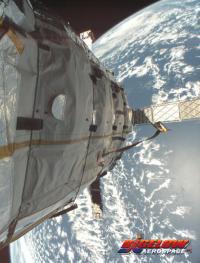
Image Credit : NASA
CASIS is steadily expanding its portfolio of research to be conducted aboard the International Space Station. On March 14, it issued a Request for Information looking for partners to assist with expanding the scope of non-embryonic stem cell research. The RFI specifically seeks organizations with expertise in payload development and integration which can make the process of getting experiments to orbit easier for researchers.
Yesterday, CASIS awarded two grants in the field of materials science research, outlined in the press release below. Notably, one is for an experiment to be conducted outside of the station on the NanoRacks exposed platform focused on developing a space radiation adapted, fault tolerant capability for the Gumstix line of tiny computers.
There are two basic ways of dealing with the effect of radiation in space on computer systems. The first is to develop resistant computers which are comprised of radiation hardened components. The problem with this approach in that rad hardened components tend to be very expensive, difficult to program and well behind the performance curve compared to terrestrial based systems.
The second approach, which is being pursued by SpaceX among others, is to design fault tolerant systems which use newer, more off the shelf components incorporated into an overall system which accommodates radiation through redundancy and multiple voting architectures. One of the biggest benefits is that the programming can taken place in more familiar languages.
This link, an interview with SpaceX director of certification John Muratore in Aviation Week from last year, provides an excellent explanation of the philosophy behind radiation tolerant design. What is interesting about the CASIS grant is the general implication for the future.
Based on current trends it seems likely that the near term future will see an increasing tide of small, automated spacecraft and landers, some of which will be privately funded, performing a variety of tasks throughout the solar system, ultimately aimed at simplifying the challenge of human settlement. One major obstacle; whether large, small or tiny, each will need a strategy for coping with a difficult radiation environment. A proliferation of smaller space probes would be problematic if the only option was mil-spec, radiation hardened components, but becomes more practical when following alternative approaches like those apparently being studied for Gumstix.
Even though CASIS is still struggling to establish a workable model, and ultimately independent funding, for its research activities, it is worth noting the potential long term benefits being pursued not just in terms of human health sciences, which has been an early area of focus, but also in other fields as well. One of those is providing an affordable (in this very, since it is a grant) means of testing COTS (Commercial Off the Shelf) products in the space environment. In doing so, CASIS is helping to realize the International Space Station’s potential as a useful tool in preparing for future well beyond low Earth orbit, engaging a much wider commercial audience in the process.
CASIS Press Release:
CASIS Announces Grant Awards for Materials Science
KENNEDY SPACE CENTER, FL. (March 21, 2013) – The Center for the Advancement of Science in Space (CASIS), the nonprofit organization promoting and managing research onboard the International Space Station (ISS) U.S. National Laboratory, today announced grant awards totaling $400,000 for two projects from its recent Request for Proposals (RFP) titled “Materials Testing in the Extreme Environment of Space.”
The RFP sought to identify projects within the field of materials science that could make use of the physical and chemical properties influenced by microgravity, atomic oxygen, low pressure and/or vast temperature variations. The selected experiments will use the NanoRacks External Platform, which allows exposure to the extreme conditions of space for development and testing of new materials, components and systems.
Grant awardees include:
Kathleen Morse, Ph.D., from Advanced Materials Applications, LLC, who will focus on using the Gumstix™ Computer On Module in ground and space-based radiation studies to examine fault-tolerant computers to meet the intensive demands of current and next generation satellites and space missions.
W. Jud Ready, Ph.D., from the Georgia Institute of Technology, who will focus on further developing cost-effective, energy-efficient photovoltaic cells made of lightweight carbon nanotubes. Past work, which began in 2011, successfully demonstrated an increased efficiency in capturing photons and creating energy. The technology is expected to be in commercially available products in fall 2013.
Final award of grant money is contingent upon the acceptance of legal terms and conditions between recipients and CASIS.
“The involvement of CASIS in the External Platform Program has opened the door to commercial utilization of the space environment far faster than previously possible,” said NanoRacks Managing Director Jeff Manber. “We are delighted to partner with CASIS in this new era of utilization on the International Space Station.”
“Today’s announcement further demonstrates the ability of CASIS to fund research to utilize the ISS National Lab,” said CASIS Interim Executive Director Jim Royston. “CASIS is excited about the ability to take advantage of the NanoRacks External Platform and fund opportunities to not only utilize the inside of the station but also promote experiments conducted outside in the extreme environment of space.”










